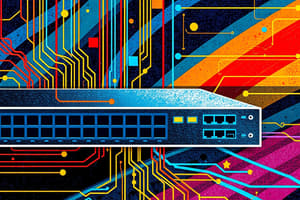Podcast
Questions and Answers
What components are typically found inside a router?
What components are typically found inside a router?
- Switching and scheduling (correct)
- Input ports and output ports (correct)
- Input ports and routing protocols
- Buffer management and ICMP protocol
Which of the following is a key function of the network layer?
Which of the following is a key function of the network layer?
- Flow control management
- Session establishment
- End-to-end communication
- Path selection algorithms (correct)
What does the term 'Generalized Forwarding' refer to in SDN?
What does the term 'Generalized Forwarding' refer to in SDN?
- Routing protocols like OSPF
- Match and action principles (correct)
- Buffer management in routers
- IP address resolution
What is the primary purpose of Network Address Translation (NAT)?
What is the primary purpose of Network Address Translation (NAT)?
Which protocol is primarily used for error reporting in the network layer?
Which protocol is primarily used for error reporting in the network layer?
What is the primary purpose of the Time to Live (TTL) field in a packet's header?
What is the primary purpose of the Time to Live (TTL) field in a packet's header?
In the context of IP addressing, what does the subnet part of an IP address indicate?
In the context of IP addressing, what does the subnet part of an IP address indicate?
What is typically the maximum length of an IP packet, not including its overhead?
What is typically the maximum length of an IP packet, not including its overhead?
Which of the following correctly describes a router's interfaces?
Which of the following correctly describes a router's interfaces?
What does the checksum field in a packet's header help to verify?
What does the checksum field in a packet's header help to verify?
Flashcards are hidden until you start studying
Study Notes
Network Layer Overview
- The network layer consists of data plane and control plane operations.
- Routers contain input ports, switching mechanisms, output ports, buffer management, and scheduling.
Internet Protocol (IP)
- IP is fundamental for packet delivery across networks.
- Datagram format includes fields such as version, header length, type of service, checksum, and addresses.
- Source and destination IP addresses are 32 bits in length with a maximum datagram size typically limited to 1500 bytes.
Addressing and Network Address Translation
- IP addresses serve as unique 32-bit identifiers for each host or router interface.
- A router may have multiple interfaces, while a host generally has one or two interfaces (like wired Ethernet or wireless).
- Dotted-decimal notation represents binary IP addresses for easy readability.
Subnets
- Subnets are created when devices share common high-order bits in their IP addresses, allowing direct communication without routing.
- The structure of an IP address divides it into subnet and host parts.
- To define a subnet, interfaces are isolated, creating distinct subnetwork segments.
Packet Handling and Forwarding
- Generalized forwarding utilizes match-action principles, particularly in Software-Defined Networking (SDN).
- OpenFlow exemplifies match-action functionality, streamlining thoughts on packet handling.
- Routing protocols, such as OSPF and BGP, organize how packets traverse the network.
Protocols and Signaling
- ICMP provides error reporting and router signaling necessary for network diagnostics.
- Path selection algorithms are essential for routing decisions, determining optimal data paths.
Fragmentation and Reassembly
- The datagram may require fragmentation for transmission, with necessary headers included for reassembly on the receiving end.
- The TCP layer typically adds an overhead of 20 bytes, coupled with the 20 bytes from the IP layer.
Key Takeaways
- Understanding the structure of IP packets and the mechanics of subnets is crucial for efficient networking.
- Familiarity with network protocols and their operational context aids in grasping the complexities of data transmission and routing.
Studying That Suits You
Use AI to generate personalized quizzes and flashcards to suit your learning preferences.




